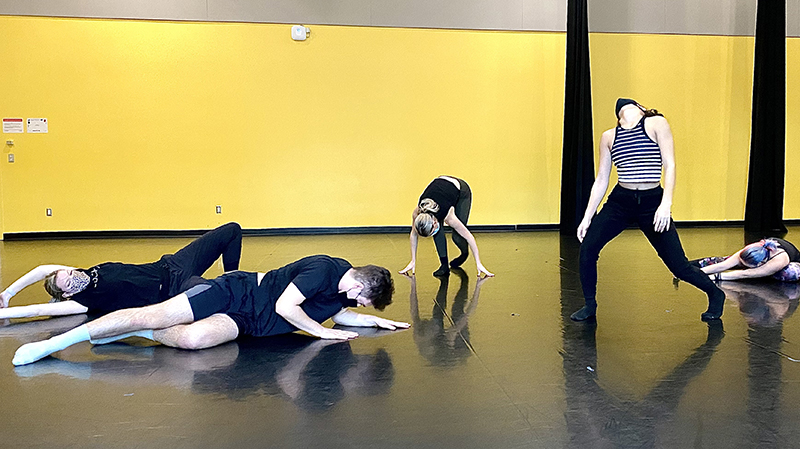
Dance Innovations 2021: Liminal Spaces, running Nov. 30 to Dec. 2, features new choreographic works by 21 fourth-year dance BFA students. Performed by students in all years of York’s undergraduate program in dance, this livestreamed series engages with pandemic-inflected themes of encounter and juncture.
“For this year’s installment of Dance Innovations, we are creating in-person, live works supported by technology that will allow student work to be viewed digitally,” explains Dance Innovations Artistic Director Tracey Norman. “This is a big change over previous productions during the pandemic where everything was done virtually. There are, however, still components that are new and disorienting – hence the name Liminal Spaces. Nevertheless, we have the liveness of one another in the studio to accrue collective inspiration.”
Liminal Spaces focuses on the transitory moment of collective disorientation. United under the theme of "Intersection" that is being explored through the Dance Department’s events and performances for 2021-22, choreographers investigate the overlaps, counterpoints and margins they have experienced throughout these past 20 months of the COVID-19 pandemic. Faculty specializing in composition, performance, light design and production supported student artists in their explorations of these spaces. Presented as three series – Encounter, Collide and Junction – Liminal Spaces also features a world premiere by Assistant Professor Susan Lee for the Dance Department’s third-year performance class.

An example of the interplay with the notion of liminality, fourth-year dance major Kyra Todd’s work, Infinite Abyss, asks is there is more to this mundane existence? With performers Cecelia Arva, Talia Cooper, Christiano DiDomenico, Taylor Hooey and Andrea St-Amant, Todd considers how “busy lives” often create “a rigid outside form” designed to neither “bend nor break.” Instead, she asks, “what would happen if that outside shell lifted like a fog to reveal more to our characters and even more to the possibilities within our world?” Todd’s five dancers react to their surroundings as if they are always on the cusp of breaking free. Constantly reaching the limits of their movements, the dancers are “pulled down” and prevented from realizing their goal.

In a similar vein, Coleen Satchwell’s piece Forward, choreographed in collaboration with Zuri Skeete, analyses individual experiences with being stuck and how to create the necessary space to rebuild and grow. Satchwell explains: “It may seem easier to put aside or hide problems rather than face them head on, especially when we are feeling weak, whether it’s because of a job you hate, a relationship that just isn't right, or sinking in debt. How do we continue to progress and move forward when we are overwhelmed in these situations?” Performed as a solo by Skeete, Forward promises to embody how every day people have the power to make choices, to make changes and to take chances.
Sydney Cobham’s work, Charged Motion, takes a more biological approach to the forces that propel us. With dancers, Natacha Aaron, Reece Caldwell, Nicole Faithfull and Mackenzie Grantham, Charged Motion, is a collaborative work that explores the body's own internal magnetic fields. “These fields,” Cobham explains, “are generated by the extraordinary amount of internal electrical movement, keeping our bodies alive. This piece came from a new fascination with the natural force of magnetism. After further research, magnetic fields became the inspiration for choreographic development.” The process of creation involved improvisational scores, movement experimentation and verbal prompts. From there, movement materials were found and repurposed into phrases. Charged Motion offers audience members a creative point of view of how magnetic fields around the body naturally affect one another. It explores the relationship within one’s internal space and between the dancers together.

“From the outset there’s been a hunger in this group of emerging choreographers and performers to make new work, create new experiences. In this moment there is so much that is new and unexpected,” says Norman. “The protocols in place to keep us safe mean that these choreographers are finding ways of exploring intimacy without touch, emotion without facial expression, voice without a visible mouth, connection with an audience not in the room. The setbacks have been different than in previous rehearsal and creation periods during COVID, but the discoveries far outweigh the setbacks.” As a first-time artistic director for Dance Innovations, Norman is relying on colleagues who are directly involved in bringing this project to fruition. “Susan Lee, Jennifer Jimenez, Wesley McKenzie and I have been unwavering in our support of these choreographers who are dancing in the most inventive of ways, bolstering my understanding of how dance brings us together in any and all circumstances.”
Dance Innovations 2021: Liminal Spaces
Artistic director: Tracey Norman
Course director Third-Year Performance: Susan Lee
Production manager: Wesley McKenzie
Lighting design course director: Jennifer Jimenez
Livestream PERFORMANCES:
Tuesday, Nov. 30 at 7 p.m. – Series A: Encounter
Wednesday, Dec. 1 at 7 p.m. – Series B: Collide
Thursday, Dec. 2 at 7 p.m. – Series C: Junction
Admission: Sliding scale $5 to $25
Box Office: 416-736-5888 or online at ampd.yorku.ca/boxoffice
